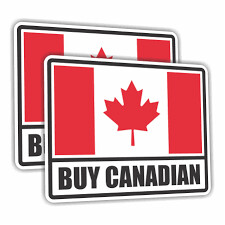
A wave of economic nationalism is altering the retail landscape in Canada, as consumers increasingly prioritize locally made products over American imports. The “Buy Canadian” movement, once a niche sentiment, has gained widespread traction, influencing both shopping habits and corporate strategies.
This shift echoes similar movements in other countries where economic and political tensions have fueled domestic purchasing preferences. In the United States, campaigns such as “Buy American” have long encouraged consumers to support domestic industries. Likewise, in the European Union, initiatives promoting locally sourced goods have seen periodic surges, often in response to trade disputes. In Canada, however, the movement appears to be driven not just by patriotic sentiment but also by economic retaliation against U.S. trade policies.
U.S. Companies Adjust Strategies Amid Market Shifts
With Canadian retailers reducing their reliance on American products, U.S.-based businesses are being forced to rethink their market strategies. Many companies that previously relied on seamless cross-border trade are now facing distribution challenges, forcing them to either scale back operations or explore alternative approaches to maintain their presence.
Some firms are considering localized production to circumvent potential consumer backlash. By manufacturing products in Canada, they hope to regain favor with retailers and consumers alike. Others are rebranding their products to align more closely with Canadian identity, emphasizing bilingual packaging and localized marketing campaigns. However, for many, these adaptations may not be enough to offset the increasing preference for Canadian brands.
The rapid spread of consumer nationalism has been amplified by social media platforms, where grassroots campaigns advocating for locally made products have gained momentum. Social media users are actively promoting Canadian brands, influencing purchasing decisions, and calling out retailers that continue to prioritize American imports.
This digital activism has had tangible consequences for businesses. The visibility of online discussions has made it easier for consumers to scrutinize product origins, leading to swift changes in shopping behavior. Canadian shoppers, who may not have previously considered where their goods were made, are now making more informed choices, further accelerating the movement.
Retailers Adjust Inventories to Meet Consumer Demand
Major Canadian retailers are navigating this shift by reassessing their inventory strategies. While some are making deliberate efforts to stock more Canadian-made products, others are adopting a more cautious approach, monitoring consumer sentiment before making definitive changes.
Retailers that once relied on American suppliers are now exploring partnerships with Canadian manufacturers to fill gaps in their product offerings. Some have subtly reduced their orders from U.S. companies, opting for a gradual transition rather than an outright removal of American goods. This strategy minimizes risk while still aligning with consumer expectations. However, for U.S. companies facing a decline in sales, even a modest reduction in shelf space can have significant financial implications.
As American brands struggle to maintain their foothold in Canada, domestic manufacturers are seeing unprecedented growth. Companies that previously struggled to compete with well-established U.S. brands are now receiving increased interest from retailers eager to showcase homegrown alternatives.
This surge in demand is particularly beneficial for small and mid-sized Canadian businesses, which are seizing the opportunity to expand their market presence. Some manufacturers have reported quadrupled shipment volumes, while others have been able to secure long-sought-after retail partnerships. The momentum of the “Buy Canadian” movement has provided them with a competitive advantage that was previously out of reach.
While trade tariffs have historically been a major factor in cross-border commerce, the current disruption stems largely from consumer behavior rather than government-imposed restrictions. The shift in Canadian purchasing preferences is a response to broader political tensions, including recent trade disputes and policy decisions that have strained U.S.-Canada relations.
Unlike traditional trade barriers, which are imposed by governments, this form of disruption is organic and driven by the collective decisions of individual consumers and businesses. The unpredictability of consumer sentiment makes it difficult for U.S. companies to devise clear counterstrategies, as economic policies alone may not be enough to reverse the trend.
Different Industries Face Varying Levels of Disruption
Not all sectors are affected equally by the “Buy Canadian” movement. Some industries, such as baby products and beverages, have seen immediate and noticeable shifts in consumer preferences, while others, like personal care and cosmetics, are experiencing more gradual changes.
In the baby product sector, Canadian manufacturers have reported a sharp increase in demand, as parents consciously choose locally made diapers over American alternatives. Similarly, U.S. beverage companies are struggling to maintain their market share, with liquor stores opting to stock more Canadian whiskey and beer instead of American imports. Meanwhile, industries with fewer Canadian alternatives, such as high-end cosmetics, have so far seen a less dramatic impact.
While the “Buy Canadian” movement is largely consumer-driven, government policies also play a role in shaping the business landscape. Canadian policymakers have introduced incentives to support domestic manufacturers, further reinforcing the trend toward locally produced goods.
At the same time, officials are taking a measured approach to avoid escalating trade tensions. While there have been no official restrictions on U.S. imports, government messaging has subtly encouraged consumers and businesses to prioritize Canadian products whenever possible. This indirect support, combined with shifting consumer sentiment, is creating an environment where local brands continue to thrive.
The momentum of the “Buy Canadian” movement suggests that this shift in consumer behavior is more than just a temporary reaction to political tensions. As Canadian manufacturers expand and solidify their presence, and as retailers adjust their product selections, American brands may find it increasingly difficult to reclaim their lost market share.
For U.S. businesses looking to maintain their foothold in Canada, adapting to this evolving landscape will require more than just short-term fixes. Whether through localizing production, forming strategic partnerships, or rethinking marketing strategies, companies must acknowledge the growing influence of economic nationalism and find ways to align with the changing preferences of Canadian consumers.
(Source:www.tbsnews.net)
This shift echoes similar movements in other countries where economic and political tensions have fueled domestic purchasing preferences. In the United States, campaigns such as “Buy American” have long encouraged consumers to support domestic industries. Likewise, in the European Union, initiatives promoting locally sourced goods have seen periodic surges, often in response to trade disputes. In Canada, however, the movement appears to be driven not just by patriotic sentiment but also by economic retaliation against U.S. trade policies.
U.S. Companies Adjust Strategies Amid Market Shifts
With Canadian retailers reducing their reliance on American products, U.S.-based businesses are being forced to rethink their market strategies. Many companies that previously relied on seamless cross-border trade are now facing distribution challenges, forcing them to either scale back operations or explore alternative approaches to maintain their presence.
Some firms are considering localized production to circumvent potential consumer backlash. By manufacturing products in Canada, they hope to regain favor with retailers and consumers alike. Others are rebranding their products to align more closely with Canadian identity, emphasizing bilingual packaging and localized marketing campaigns. However, for many, these adaptations may not be enough to offset the increasing preference for Canadian brands.
The rapid spread of consumer nationalism has been amplified by social media platforms, where grassroots campaigns advocating for locally made products have gained momentum. Social media users are actively promoting Canadian brands, influencing purchasing decisions, and calling out retailers that continue to prioritize American imports.
This digital activism has had tangible consequences for businesses. The visibility of online discussions has made it easier for consumers to scrutinize product origins, leading to swift changes in shopping behavior. Canadian shoppers, who may not have previously considered where their goods were made, are now making more informed choices, further accelerating the movement.
Retailers Adjust Inventories to Meet Consumer Demand
Major Canadian retailers are navigating this shift by reassessing their inventory strategies. While some are making deliberate efforts to stock more Canadian-made products, others are adopting a more cautious approach, monitoring consumer sentiment before making definitive changes.
Retailers that once relied on American suppliers are now exploring partnerships with Canadian manufacturers to fill gaps in their product offerings. Some have subtly reduced their orders from U.S. companies, opting for a gradual transition rather than an outright removal of American goods. This strategy minimizes risk while still aligning with consumer expectations. However, for U.S. companies facing a decline in sales, even a modest reduction in shelf space can have significant financial implications.
As American brands struggle to maintain their foothold in Canada, domestic manufacturers are seeing unprecedented growth. Companies that previously struggled to compete with well-established U.S. brands are now receiving increased interest from retailers eager to showcase homegrown alternatives.
This surge in demand is particularly beneficial for small and mid-sized Canadian businesses, which are seizing the opportunity to expand their market presence. Some manufacturers have reported quadrupled shipment volumes, while others have been able to secure long-sought-after retail partnerships. The momentum of the “Buy Canadian” movement has provided them with a competitive advantage that was previously out of reach.
While trade tariffs have historically been a major factor in cross-border commerce, the current disruption stems largely from consumer behavior rather than government-imposed restrictions. The shift in Canadian purchasing preferences is a response to broader political tensions, including recent trade disputes and policy decisions that have strained U.S.-Canada relations.
Unlike traditional trade barriers, which are imposed by governments, this form of disruption is organic and driven by the collective decisions of individual consumers and businesses. The unpredictability of consumer sentiment makes it difficult for U.S. companies to devise clear counterstrategies, as economic policies alone may not be enough to reverse the trend.
Different Industries Face Varying Levels of Disruption
Not all sectors are affected equally by the “Buy Canadian” movement. Some industries, such as baby products and beverages, have seen immediate and noticeable shifts in consumer preferences, while others, like personal care and cosmetics, are experiencing more gradual changes.
In the baby product sector, Canadian manufacturers have reported a sharp increase in demand, as parents consciously choose locally made diapers over American alternatives. Similarly, U.S. beverage companies are struggling to maintain their market share, with liquor stores opting to stock more Canadian whiskey and beer instead of American imports. Meanwhile, industries with fewer Canadian alternatives, such as high-end cosmetics, have so far seen a less dramatic impact.
While the “Buy Canadian” movement is largely consumer-driven, government policies also play a role in shaping the business landscape. Canadian policymakers have introduced incentives to support domestic manufacturers, further reinforcing the trend toward locally produced goods.
At the same time, officials are taking a measured approach to avoid escalating trade tensions. While there have been no official restrictions on U.S. imports, government messaging has subtly encouraged consumers and businesses to prioritize Canadian products whenever possible. This indirect support, combined with shifting consumer sentiment, is creating an environment where local brands continue to thrive.
The momentum of the “Buy Canadian” movement suggests that this shift in consumer behavior is more than just a temporary reaction to political tensions. As Canadian manufacturers expand and solidify their presence, and as retailers adjust their product selections, American brands may find it increasingly difficult to reclaim their lost market share.
For U.S. businesses looking to maintain their foothold in Canada, adapting to this evolving landscape will require more than just short-term fixes. Whether through localizing production, forming strategic partnerships, or rethinking marketing strategies, companies must acknowledge the growing influence of economic nationalism and find ways to align with the changing preferences of Canadian consumers.
(Source:www.tbsnews.net)





